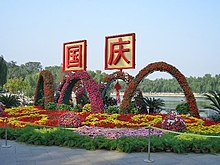There are currently seven official public holidays on Mainland China.[1][2] Each year's holidays are announced about one month before the start of the year by the General Office of the State Council. A notable feature of mainland Chinese holidays is that weekends are usually swapped with the weekdays next to the actual holiday to create a longer holiday period.
| Date | Length (without weekends)[1] | English name | Chinese name (Simplified) | Pinyin | Remarks |
|---|---|---|---|---|---|
| 1 January | 1 day | New Year's Day | 元旦 | Yuándàn | |
| 1st day of 1st Lunisolar month | 4 days (Chinese New Year's Eve, 1st, 2nd and 3rd days of 1st Lunisolar month)[1] | Spring Festival[a] (aka Chinese New Year) | 春节 | Chūnjié | Usually occurs in late January or early February. The most important holiday, celebrating the start of a new year |
| 5 April (4 or 6 April in some years) | 1 day | Tomb-Sweeping Day | 清明节 | Qīngmíng jié | Occurs about 15 days after the March Equinox; day for paying respect to one's ancestors |
| 1 May | 2 days[1] | Labour Day | 劳动节 | Láodòng jié | International Workers' Day |
| 5th day of 5th Lunisolar month | 1 day | Dragon Boat Festival | 端午节 | Duānwǔ jié | Usually occurs in June; commemoration of the ancient poet Qu Yuan |
| 15th day of 8th Lunisolar month | 1 day | Mid-Autumn Festival | 中秋节 | Zhōngqiū jié | Usually occurs in September; important autumn celebration of harvest and togetherness |
| 1 October | 3 days[1] | National Day | 国庆节 | Guóqìng jié | Commemorating the formal proclamation of the establishment of the People's Republic of China on 1 October 1949 |

- ^ a b c d e "国务院关于修改《全国年节及纪念日放假办法》的决定". 2024-11-10.
- ^ "国务院关于修改《全国年节及纪念日放假办法》的决定". China.com.cn. 2016-05-13.
Cite error: There are <ref group=lower-alpha> tags or {{efn}} templates on this page, but the references will not show without a {{reflist|group=lower-alpha}} template or {{notelist}} template (see the help page).